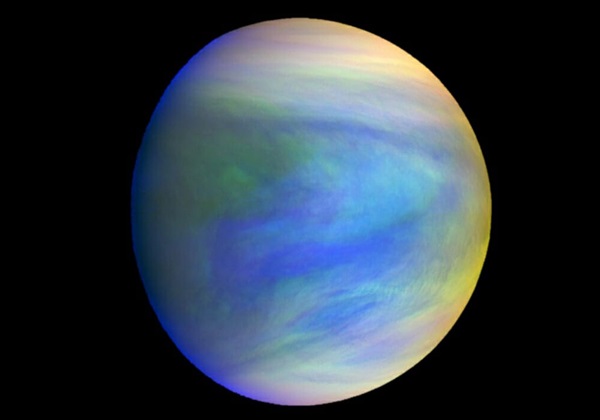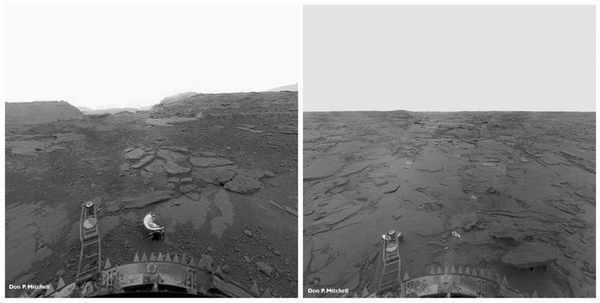Key Takeaways:
Venus is often called Earth’s sibling planet. Yet despite similarities in size and composition, this nearby world is hellish, unlike Earth’s paradisical climes. Shrouded in clouds of sulfuric acid that hide a surface with temperatures that can reach 880 degrees Fahrenheit (471 degrees Celsius), even six decades of successful robotic exploration have left many venusian enigmas unanswered.
Now that’s changed. In a paper published April 29 in Nature Astronomy, Jean-Luc Margot of the University of California, Los Angeles, and his team describe how they used a clever way of analyzing radio waves to pin down several of Venus’s most basic properties. And it took them only 15 years.
Using the revolutionary technique, Margot’s team measured Venus’ axial tilt (the difference between the planet’s rotational axis and a line perpendicular to its orbital plane), day length, moment of inertia (a factor that affects how the planet spins, based on how its interior is structured), and core size. Previous estimates of these properties have significant uncertainties or varied from one measurement to the next.
Such uncertainties have real-world consequences: For example, current ambiguities mean the position of a given location on Venus could be off by up to 20 miles (30 kilometers) after three decades. That’s not the kind of error one wants when trying to put a lander on the surface.
Spin like a disco ball
Margot’s journey began in 2001, when he received a memo from a colleague about a radio telescope technique first discussed in the early 1960s, he tells Astronomy. After concluding the idea was sound, he says, “it was worth figuring out the practical implementation.”
Margot calls the technique radar speckle tracking. Imagine a rotating disco ball with a spotlight shining on it. Any reflected light appears speckled, with each surface on the ball bouncing back light at a slightly different angle. Now imagine that Venus, with its rotating, irregular surface, is the disco ball. A radio telescope dish on Earth is the spotlight, sending out a powerful blast of radio waves. And the echo that bounces back appears speckled because Venus’ surface isn’t perfectly smooth.
To get the most accurate measurements, the team needed to receive echoes at two widely spaced locations. The difference in time between when one antenna sees the echo and the other is related to how fast Venus is spinning. And the amount by which the signals appear identical or different between the two locations is related to Venus’ tilt. Both receivers must record the echo for the observation to work. Margot’s team used NASA’s 70-meter radio antenna at its Goldstone Deep Space Communications Complex in California and the 100-meter Green Bank radio telescope in West Virginia, more than 1,860 miles (3,000 km) away.
They first used the technique on Mercury — a planned research project that had already been approved for funding. It worked beautifully, says Margot. They measured the planet’s rotation period with an accuracy of 0.001 percent. The team also determined that the planet’s outer core is molten, which had not previously been known.
Getting the most accurate measurements required observing for a long period of time. The Mercury observations took about 10 years. Why did Venus take 15? Two major reasons were Venus’s tiny axial tilt and the planet’s precession (the motion of Venus’ spin axis over time, the same way a spinning top will wobble). “The precessional motion for Earth and Venus is actually about the same,” Margot says. “What is different is that Earth has a substantial [axial] tilt” — 23.4° — “so [its pole] traces this large cone on the sky.” By comparison, Venus’s axial tilt is around 2.7°. “That means a tiny little cone in the sky and a motion of the pole of only 2″ per year.” That requires many years of observation to measure a significant change.
On top of all that, observation time with the Goldstone antenna was very limited. The dish is part of the Deep Space Network used to communicate with various space probes. Often, the team’s scheduled time with the dish would be canceled in lieu of a higher-priority request for the facility.
The payoff
The team began observing Venus in 2006. Originally, they asked for 121 separate observing sessions and ultimately got about 50. By 2020, they’d managed to make 21 observations that produced usable data. “It’s a challenging measurement to make and it requires both high precision and patience,” Margot reaffirms with a smile.
The results of their patience and precision are remarkable. The team found that the average day on Venus (between 2006 and 2020) was 243.0226 Earth days long. What’s more, the venusian day varies in length by as much as 20 minutes. Margot thinks this is caused in part by Venus’s extremely dense atmosphere, which, unlike the solid surface below, has a rotation period of just four days. As the atmosphere “sloshes about” above Venus, it transfers some angular momentum to the planet itself.
The team also found that Venus’s axis is tilted by 2.6392°, a tenfold increase in accuracy over earlier estimates. The precession rate — how fast Venus’ pole wobbles — is 44.58″ per year, which means the pole draws a complete circle on the sky every 29,000 years. A more accurate precession rate gave the team a measure of the planet’s moment of inertia, which in turn gave a rough estimate of the size of Venus’ core, which was previously unknown. Margot’s team found it’s roughly 2,175 miles (3,500 km) across — about the same size as Earth’s.
But do the similarities stop there? Our planet’s core has an outer molten layer and a solid center, but what about Venus’ core? At this point, Margot says, we can’t be certain. Recent computer modeling suggests it could be either solid or molten, or perhaps solid at the center with a molten outer region, like Earth’s. Margot thinks it’s probably entirely liquid, but would love for additional data from ongoing speckle observations to confirm it. Alternatively, he says, direct observational evidence for the core’s size could come from tracking the motion of an orbiter around Venus and measuring tidal deformations induced in the planet by the Sun. “The ultimate best way [to learn about the core] is to have seismometers on the surface; but that’s not going to happen soon,” he adds, because of the planet’s hellish conditions.
Working from home
While they continue their work on Venus, Margot’s team is also using radar speckle tracking on Jupiter’s moons Europa and Ganymede. Astronomers strongly believe Europa has a global ocean beneath its icy surface and Ganymede likely may as well. But using this technique to observe these moons is far more challenging than Mercury or Venus because of the distance involved, so the radar echoes received over that vast distance are thousands of times weaker. The team’s early results, though, already suggest Europa “has an exterior layer that is decoupled from the interior of the body,” Margot says, confirming that it does indeed have a subsurface global ocean.
We have become used to the remarkable discoveries made by robotic space probes circling or even driving about on our celestial neighbors. And why not? But Margot and his team remind us that equally astonishing new knowledge of the cosmos, including our sibling planet, is being acquired from right here on Earth.












